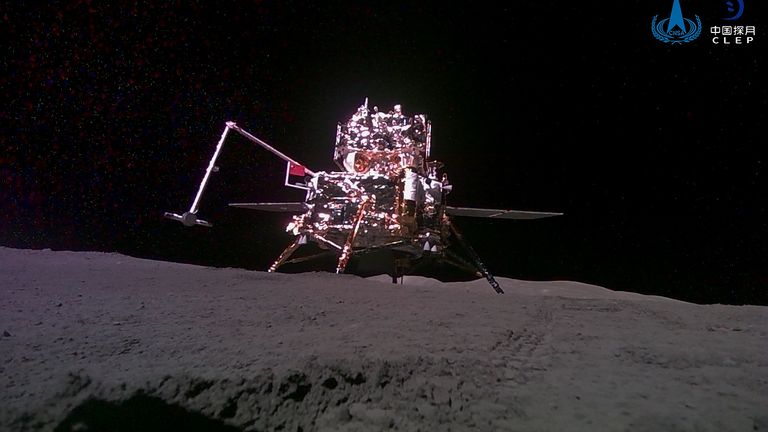China's lunar probe has returned to Earth, making the country the first to bring back samples from the moon's far side.
The re-entry capsule of the Chang'e probe touched down in the northern Chinese region of Inner Mongolia at about 2pm Beijing time (7am UK time), carrying lunar soil collected earlier in June.
At the start of the month, the probe had successfully landed at the moon's South Pole, in the Aitken Basin, a gigantic impact crater that always faces away from Earth.
Chinese scientists anticipate the returned samples will include 2.5-million-year-old volcanic rock and other material that they hope will answer questions about geographic differences on the moon's two sides.
The moon's near side - which always faces the Earth - is flatter and has fewer impact craters. The far side always faces outer space.
Why the same side of the moon always faces the Earth
Wherever people may be on Earth, they will always see the same side of the moon.
That is because the moon takes as long to rotate on its own axis as it does to complete its monthly orbit around our planet.
This phenomenon is known as synchronous tidal locking, whereby the moon started off spinning faster than it does now, but then slowed and ended up facing the Earth as it does now, according to NASA.
But it's not just the moon which synchronises with Earth.
In fact, the phenomenon is quite common, with all the solar system's large moons tidally locking with their planets. And in some cases, stars also do the same when they have binary pairs.
The samples will be transferred by air to Beijing, state media outlet CCTV reported, and analysed by both Chinese and foreign scientists.
Chinese President Xi Jinping said the mission's completion was a "landmark achievement" in China's quest to become a space and scientific powerhouse.
Read more:
Why the moon's south pole is the chequered flag of space race 2.0
Moon to get its own time zone created by NASA
Chang'e 6 confirms China as rising space science superpower
 Tom Clarke
Tom Clarke
Science and technology editor
@t0mclark3The return of Chang’e 6 hasn’t just achieved a world-first for lunar exploration - it’s confirmed China’s reputation as a rising space science superpower.
Executing a robotic “soft-landing” on the moon is hard. In the last year, three such missions have ended in failure and one was only a partial success.
But with Chang’e 6, China not only pulled off its fourth successful lunar landing in a row, it did so on the far side of the moon where terrain is more rugged and communications with Earth severely limited. China remains the only country to have landed there.
Not only that, Chang’e 6 executed a number of complex operations – many totally autonomously – to bring back the first ever samples of rock and soil from the unexplored far side.
Scientists are genuinely excited about what the analysis of these rocks might tell us about the origins of the moon and our solar system.
Meanwhile politicians are grappling with the realities of a new space race between the US and its allies and China and theirs.
Each has stated ambitions to establish a presence on the moon to explore its geological secrets -- but also to exploit its potential resources.

Missions to the moon's far side are more difficult because a relay satellite is required to maintain communications.
The probe left earth on 3 May to collect samples which are expected to answer "one of the most fundamental scientific questions in lunar science research," Zongyu Yue, a geologist at the Chinese Academy of Sciences, said.
"What geologic activity is responsible for the differences between the two sides?"
China is catching up with US on space landings
Nicole JohnstonAsia correspondent
@nicole_reporterFor China the successful landing of its lunar mission back to earth is being touted as evidence of the country’s rising space and scientific supremacy.
Space is another area where geo-political rivalry between the US and China is heating up.
Both countries want to land an astronaut on the moon and walk on its surface. They are aiming to do it by 2030.
NASA was planning to carry out its mission in 2026.
But it has been beset by delays and China is catching up.
It wants to beat the US and build a permanent base on the south pole of the moon.
Scientists believe there is ice in the south pole region and access to water could enable the dream of a permanent station on the moon to become a reality.
China's Xinhua News Agency previously said the Aitken Basin - an impact crater eight miles deep and 1,500 miles wide - is thought to have been created more than four billion years ago.
It is the oldest and largest such crater on the moon, so could provide significant information because the original impact may have ejected materials from deep below its surface.
Keep up with all the latest news from the UK and around the world by following Sky News
Tap hereThe mission comes amid a growing space rivalry among countries including China, India, Japan and the US.
Beijing aims to put a person on the moon by 2030, while US agency NASA hopes to achieve the feat again in September 2026.
Disclaimer: The copyright of this article belongs to the original author. Reposting this article is solely for the purpose of information dissemination and does not constitute any investment advice. If there is any infringement, please contact us immediately. We will make corrections or deletions as necessary. Thank you.



